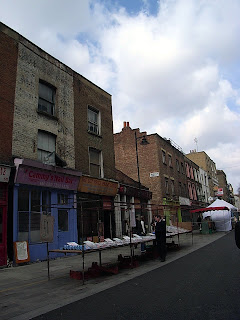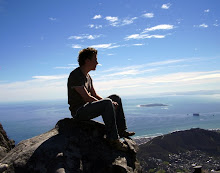The beauty of London is that you can quite easily get lost, which is great for discovering new things! However, another good thing about London is that however lost you may be if you walk in a random direction you some how eventually do manage to get to your chosen destination.
Smithfield:
 Starting off from Smithfield's market, an ancient meat market that has been trading for over 800 years. Near to the market is St. Bartholomew the Great a church founded in 1123 as part of an Augustinian Priory. I then walked through the narrow streets before coming to the Barbican and Fann Street Wildlife Park. It is one of only two wildlife sanctuaries in the city and helps to create a green grid of habitats. Managed by the city of London and the Barbican Wildlife Group it has areas of rotting wood, beech hedging, cut and uncut lawn that help promote wildlife in the middle of a high density residential area.
Starting off from Smithfield's market, an ancient meat market that has been trading for over 800 years. Near to the market is St. Bartholomew the Great a church founded in 1123 as part of an Augustinian Priory. I then walked through the narrow streets before coming to the Barbican and Fann Street Wildlife Park. It is one of only two wildlife sanctuaries in the city and helps to create a green grid of habitats. Managed by the city of London and the Barbican Wildlife Group it has areas of rotting wood, beech hedging, cut and uncut lawn that help promote wildlife in the middle of a high density residential area.
Dreamspace Gallery:
Near Fann Street is the Dreamspace Gallery at Adrem. Currently it is exhibiting work by Amin Taha Architects, an up and coming practice in London. The exhibition shows models and projects of current and future projects, including the Custard Factory (Birmingham), Vauxhall Tree Gardens (London) and the New Islington Footbridge, which stretches over a crossroads in the canal system. Existing projects that can be seen are Marlborough House in London Fields and Gazzano House in Farringdon that uses Cor-ten steel to blend it in with it's historic surroundings.
By Dreamspace is Whitecross Street Market, which is Islington's oldest market. Due to it's location near Old Street it has a confused identity of scruffy run down shops and expensive boutiques. In some cases it seems that vacant shops are just used as storage for the various market stalls along the street.
 At the end of the market is a church on Old Street called St. Luke's. This is an unusual church due to the fact that instead of having a spire it has an obelisk. The church is a grade 1 listed building and is now home to the London Symphony Orchestra and is used as a rehersal, recording & education space and an intimate concert hall.
At the end of the market is a church on Old Street called St. Luke's. This is an unusual church due to the fact that instead of having a spire it has an obelisk. The church is a grade 1 listed building and is now home to the London Symphony Orchestra and is used as a rehersal, recording & education space and an intimate concert hall.
 Shoreditch:
Shoreditch:
 Wandering along Old Street I came in contact with Shoreditch country. Shoreditch is a great place because although it has a mix of new architecture and expensive bars it also has contrasting run down buildings, street art and graffiti. There are Victorian buildings that resemble ancient ruins being propped up and quirky converted customised tube carriages being used as offices for arty types.
Wandering along Old Street I came in contact with Shoreditch country. Shoreditch is a great place because although it has a mix of new architecture and expensive bars it also has contrasting run down buildings, street art and graffiti. There are Victorian buildings that resemble ancient ruins being propped up and quirky converted customised tube carriages being used as offices for arty types.


 Sweet:
Sweet:

From Shoreditch I went to Bethnal Green to see "Sweet" at the Museum of Childhood. Edible architecture has been created by artist Jaimini Patel and local school children. The work of Jamini Patel uses produce from Britain's colonial past that bought the wealth to construct the actual buildings. With detailed models being constructed from sugar, spices and cocoa. Primary and secondary school children used a trip to the museum to inspire them to create buildings of their own and replicate famous London landmarks out of recycled material, packaging, chocolate and sweets.










































